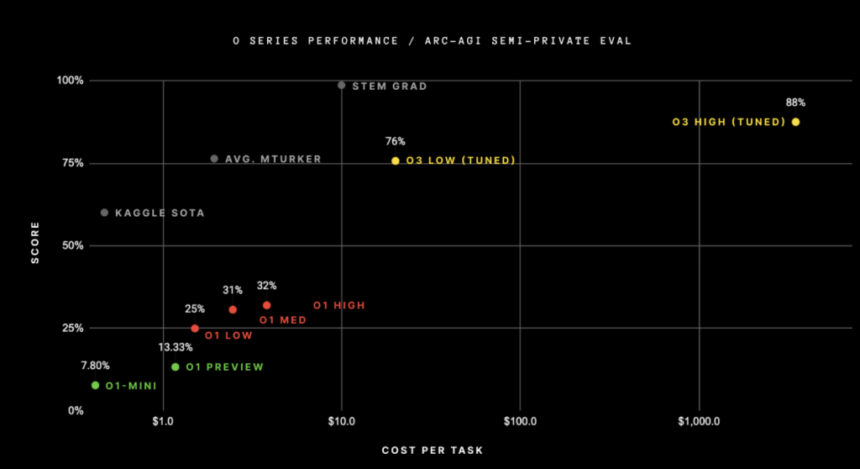

On December 20, OpenAI announced OpenAI o3, the latest model in its o-Model Reasoning Series. Building on its predecessors, o3 showcases advancements in mathematical and scientific reasoning, prompting discussions about its capabilities and constraints. This article takes a closer look at the insights and implications surrounding OpenAI o3, weaving in information from official announcements, expert analyses, and community reactions.
Progress in Reasoning Capabilities
OpenAI describes o3 as a model designed to refine reasoning in areas requiring structured thought, such as mathematics and science. The model was tested using a specialized reasoning benchmark ARC AGI, where it reportedly surpassed the previous model score of 32% and went up to 87%. This advancement demonstrates o3’s improved capacity to address complex logical and mathematical problems.

The model’s enhanced abilities stem from an architecture tailored for hierarchical reasoning tasks. While this marks a step toward broader reasoning abilities, OpenAI acknowledges that o3 is far from achieving Artificial General Intelligence (AGI).
Performance Overview

- Mathematics: Achieved a 96.7% success rate on advanced mathematical tests, a notable improvement over o1’s 56.7%.
- Scientific Reasoning: Displayed a 10% increase in accuracy for solving PhD-level Science Questions.
- Code Understanding: Demonstrated capability in comprehending and debugging code snippets, offering potential utility in software development.
Architectural Innovations
OpenAI o3 employs a hybrid reasoning framework, combining neural-symbolic learning with probabilistic logic. This architecture enables the model to:
- Break Down Problems: Simplify complex queries into smaller, manageable components.
- Leverage Context: Utilize extended memory to retain context over prolonged interactions.
- Iterate Solutions: Refine answers through multiple reasoning cycles.
These features make o3 particularly adept at tackling multi-step reasoning challenges where traditional Transformer-based models often falter.
Real-World Applications
OpenAI o3 could benefit several fields:
- Education: Assist students with complex mathematical and scientific problems.
- Healthcare: Support diagnostic processes and optimize treatment plans through data analysis.
- Software Development: Debug and generate code, providing practical support for developers.
OpenAI’s Broader Vision
OpenAI released a video that illustrates its vision for AI reasoning. The demonstrations include o3 addressing problems in physics, mathematics, and ethical dilemmas, underscoring its aspirations to develop models capable of reasoning across a wide range of scenarios.
Also, don’t forget to follow us on Twitter and join our Telegram Channel and LinkedIn Group. Don’t Forget to join our 60k+ ML SubReddit.
The post OpenAI Announces OpenAI o3: A Measured Advancement in AI Reasoning with 87.5% Score on Arc AGI Benchmarks appeared first on MarkTechPost.





 Trending: LG AI Research Releases EXAONE 3.5: Three Open-Source Bilingual Frontier AI-level Models Delivering Unmatched Instruction Following and Long Context Understanding for Global Leadership in Generative AI Excellence….
Trending: LG AI Research Releases EXAONE 3.5: Three Open-Source Bilingual Frontier AI-level Models Delivering Unmatched Instruction Following and Long Context Understanding for Global Leadership in Generative AI Excellence….

